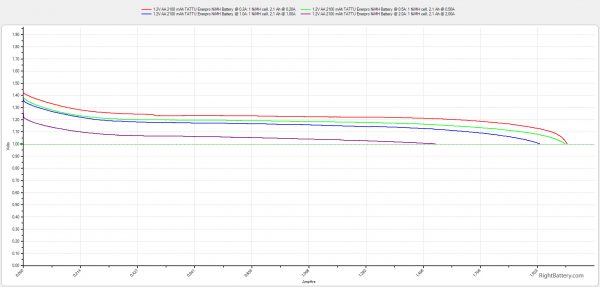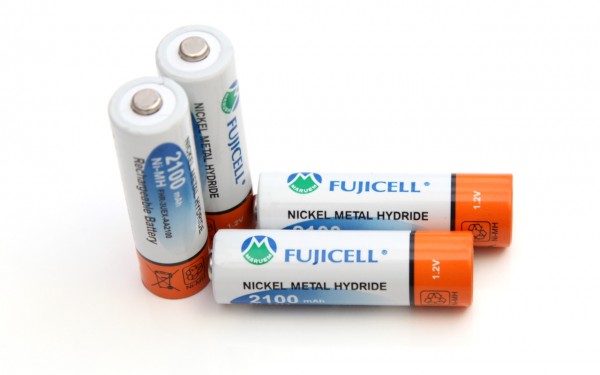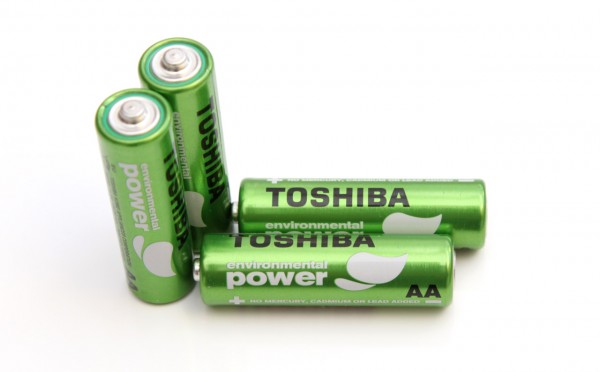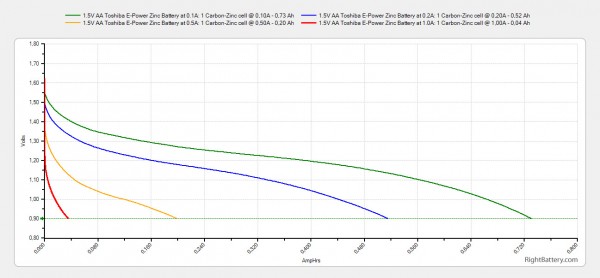RightBattery.com
Tests and reviews of different batteries to help you find the Right One…
Search
Posts Tagged ‘aa’
1.2V AA 2100 mAh TATTU Enerpro NiMH Battery Tests
27, Feb 2019
TATTU is a newer brand of batteries by Gens ace, a popular name for high quality and good priced LiPo batteries among RC enthusiasts. Here we are testing their regular 1.2V AA 2100 mAh TATTU Enerpro NiMH batteries as the company also offers higher capacity 2700 mAh model that we plan to check out soon as well. We have previously tested AA NiMH batteries from Gens ace under their own brand, you can check the results here and compare with the TATTU line if you are interested. The TATTU Enerpro NiMH batteries are low self discharge ones that retain high percentage of their initial capacity oer longer periods of time even when not being used for long time and are rated with up to 1000x recharge cycles.

The 1.2V AA 2100 mAh TATTU Enerpro NiMH batteries are performing quite well in our tests all the way up to the high 2.0A constant load where the usable capacity shows a larger drop. What we are seeing at 0.2A and 0.5A discharge current is a very similar curve and close mAh ratings, though because of the slightly lower voltage at the higher load the gap in the Wh result is a bit larger. What we are seeing here as well as with our previous tests of Gens ace branded NiMH AA cells is that even at 0.2A load (the lowest we use for AA tests) they are performing a bit under their rated capacity, even though their general performance is very good. In both cases you can say the battery rating should’ve been much better if it was with 100 mAh lower that it is being advertised.
The performance of the 1.2V AA 2100 mAh TATTU Enerpro NiMH batteries in our tests:
– 2034 mAh at 0.2A load
– 2026 mAh at 0.5A load
– 1933 mAh at 1.0A load
– 1543 mAh at 2.0A load
– 2.490 Wh at 0.2A load
– 2.392 Wh at 0.5A load
– 2.238 Wh at 1.0A load
– 1.637 Wh at 2.0A load
– For more details about the 1.2V AA 2100 mAh TATTU Enerpro NiMH batteries…
1.2V AA 2100 mAh Fujicell NiMH Battery Tests
12, Dec 2013
The 1.2V AA 2100 mAh Fujicell NiMH batteries are the NiMH model from Fujicell with lower capacity as we’ve already tested their 2800 mAh NiMH that ended up more like 2500 mAh. So far the results we’ve seen from Fujicell batteries are very good in terms of available capacity for the price these batteries are being sold at. Not the highest possible capacity and usually a bit lower than the NiHM rating, though they are probably stating the typical and no minimal capacity is mentioned anywhere, but these batteries are available at a better price than most other similar products. Now we are going to test the 2100 mAh NiMH model from Fujicell to see what it can deliver, note that the 2100 mAh rating is probably the typical and the minimum capacity is probably 2000 mah, though it is not mentioned specifically.

Starting the tests of the 1.2V AA 2100 mAh Fujicell NiMH batteries with a low constant current discharge rate of 0.2A got us 2025 mAh as useable capacity and that is not bad, though a bit short from the stated (typical?) rating and acceptable if the battery is indeed a 2000 mAh minimum rating as we suspect. Going for higher load we are still getting pretty good performance in terms of useable capacity out of these batteries. It is interesting to see how the discharge curves for the voltage drop are kind of “grouped” – for the lower and higher current loads we are using for testing.
The performance of the 1.2V AA 2100 mAh Fujicell NiMH batteries in our tests:
– 2025 mAh at 0.2A load
– 1870 mAh at 0.5A load
– 1613 mAh at 1.0A load
– 1384 mAh at 2.0A load
– 2.456 Wh at 0.2A load
– 2.237 Wh at 0.5A load
– 1.725 Wh at 1.0A load
– 1.458 Wh at 2.0A load
1.5V AA Toshiba E-Power Battery Tests
10, Dec 2013
The 1.5V AA Toshiba E-Power batteries are Carbon-Zinc primary batteries and are the third model in Toshiba’s line of such batteries. According to the manufacturer these batteries are supposed to provide 25% improved performance vs Heavy Duty line and while we still haven’t tested the standard 1.5V AA Toshiba Heavy Duty batteries, we have tested the Super Heavy Duty model, so we could compare these to the E-Power series of Carbon-Zinc products. Just a reminder, the Zinc batteries do offer shorter shelf life and lower capacity and are not suitable for high load applications as compared to the Alkaline primary batteries. The Toshiba E-Power batteries we tested here were with an expiration date 05-2015.

Time for the tests to start for the 1.5V AA Toshiba E-Power batteries beginning with a low constant current discharge rate of 0.1A and the result we got was 731 mAh as capacity. This is a decent result for a Carbon-Zinc batteries, but compared to the Toshiba Super Heavy Duty batteries the E-Power does provide less useable capacity. Increasing the load to 0.2A and the E-Power still does pretty good, though at 0.5A the performance is not that good already and 1.0A proves to be too much. As expected these batteries do perform well, but are nothing special even for Zinc batteries. They are suitable for low load applications, but not for high load ones where you should definitely consider either good Alkaline batteries or even NiMH batteries.
The performance of the 1.5V AA Toshiba E-Power batteries in our tests:
– 731 mAh at 0.1A load
– 516 mAh at 0.2A load
– 199 mAh at 0.5A load
– 36 mAh at 1.0A load
– 0.874 Wh at 0.1A load
– 0.589 Wh at 0.2A load
– 0.207 Wh at 0.5A load
– 0.036 Wh at 1.0A load